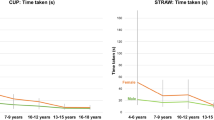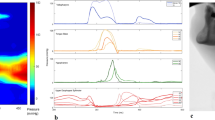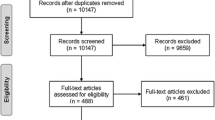Abstract
To understand disordered physiology, it is first necessary to determine what constitutes normal function. Liquid sip size during swallowing in healthy individuals has been investigated with varied results. Bolus size is a variable that is manipulated in both research studies and clinical swallowing assessments, so defining normal sip size has relevance in both domains. This study looked at sip size under instruction in experimental tasks and compared it to sip size in free drinking while participants were unaware that drinking was being observed. A statistically significant difference was found in water sip volume between natural drinking (mean = 16 ml) and instructed experimental drinking tasks (mean = 6.6–6.8 ml). This difference far exceeded the magnitude of sip-size variation observed between instructed drinking tasks using different stimuli and as a function of participant’s gender or age group.

Similar content being viewed by others
References
Logemann JA. Manual for the videofluorographic study of swallowing. 2nd ed. Austin, TX: Pro-Ed; 1993.
Halpern BP. Time as a factor in gustation: Temporal patterns of taste stimulation and response. In: Pfaff DW, editor. Decisions during sipping: taste, olfaction, and the central nervous system. New York: Rockefeller University Press; 1985. p. 181–209.
Jones DV, Work CE. Volume of a swallow. Am J Dis Child. 1961;102:427.
Adnerhill I, Ekberg O, Groher ME. Determining normal bolus size for thin liquids. Dysphagia. 1989;4(1):1–3. doi:10.1007/BF02407395.
Lawless HT, Bender S, Oman C, Pelletier C. Gender, age, vessel size, cup vs. straw sipping, and sequence effects on sip volume. Dysphagia. 2003;18(3):196–202. doi:10.1007/s00455-002-0105-0.
Nilsson H, Ekberg O, Olsson R, Kjellin O, Hindfelt B. Quantitative assessment of swallowing in healthy adults. Dysphagia. 1996;11(2):110–6. doi:10.1007/BF00417900.
Steele CM, van Lieshout PH. Does barium influence tongue behaviors during swallowing? Am J Speech Lang Pathol. 2005;14(1):27–39. doi:10.1044/1058-0360(2005/005).
Kidd D, Stout RW. The assessment of acute stroke in general medical wards. Disabil Rehabil. 1996;18(4):205–8.
Cichero JA, Murdoch BE. Detection of swallowing sounds: methodology revisited. Dysphagia. 2002;17(1):40–9. doi:10.1007/s00455-001-0100-x.
Cichero JA, Murdoch BE. Acoustic signature of the normal swallow: characterization by age, gender, and bolus volume. Ann Otol Rhinol Laryngol. 2002;111:623–32.
Steele CM, van Lieshout PH. Influence of bolus consistency on lingual behaviors in sequential swallowing. Dysphagia. 2004;19(3):192–206. doi:10.1007/s00455-004-0006-5.
Pelletier CA, Lawless HT. Effect of citric acid and citric acid-sucrose mixtures on swallowing in neurogenic oropharyngeal dysphagia. Dysphagia. 2003;18(4):231–41. doi:10.1007/s00455-003-0013-y.
Pelletier CA, Dhanaraj GE. The effect of taste and palatability on lingual swallowing pressure. Dysphagia. 2006;21(2):121–8. doi:10.1007/s00455-006-9020-0.
Logemann JA, Pauloski BR, Colangelo L, Lazarus C, Fujiu M, Kahrilas PJ. Effects of a sour bolus on oropharyngeal swallowing measures in patients with neurogenic dysphagia. J Speech Hear Res. 1995;38(3):556–63.
Meilgaard M, Civille GV, Carr BT. Sensory evaluation techniques, 3rd ed. Boca Raton, FL: CRC Press; 1999.
Acknowledgments
This research was supported by funding from the Canadian Institutes of Health Research (grants IAO-69521 and MOP-644200) and the Toronto Rehabilitation Institute, and, in part, from the Canada Research Chairs Program. Equipment and space have been funded with grants from the Canada Foundation for Innovation and the Province of Ontario. The authors acknowledge the support of Toronto Rehabilitation Institute which receives funding under the Provincial Rehabilitation Research Program from the Ministry of Health and Long-term Care in Ontario. The views expressed do not necessarily reflect those of the ministry. In addition, the authors gratefully acknowledge the assistance of Aravind Namasivayam, Mitsuko Takeuchi, and Heidi Diepstra with data collection and analysis.
Author information
Authors and Affiliations
Corresponding author
Rights and permissions
About this article
Cite this article
Bennett, J.W., Van Lieshout, P.H.H.M., Pelletier, C.A. et al. Sip-Sizing Behaviors in Natural Drinking Conditions Compared to Instructed Experimental Conditions. Dysphagia 24, 152–158 (2009). https://doi.org/10.1007/s00455-008-9183-y
Received:
Accepted:
Published:
Issue Date:
DOI: https://doi.org/10.1007/s00455-008-9183-y




